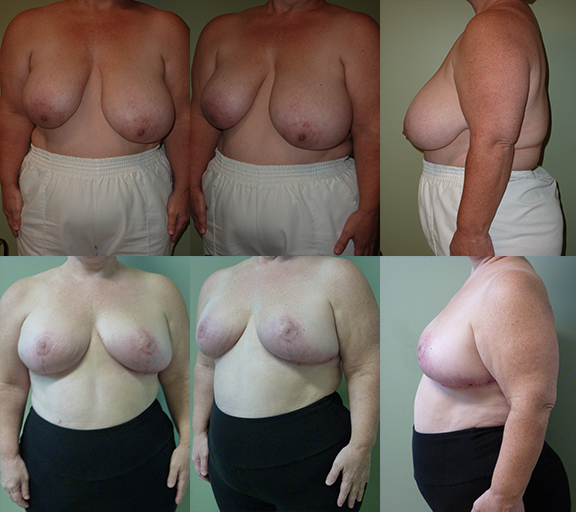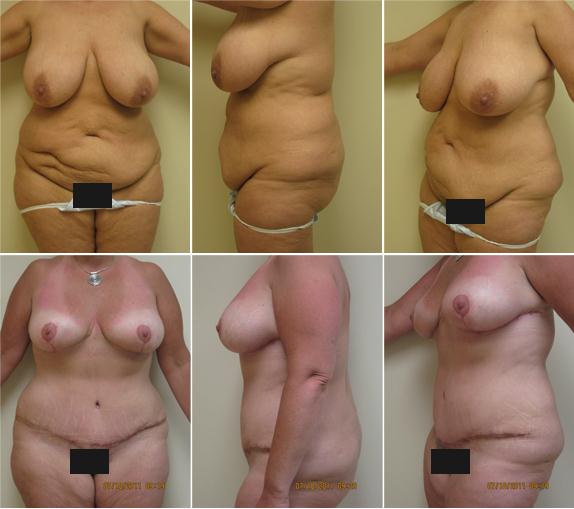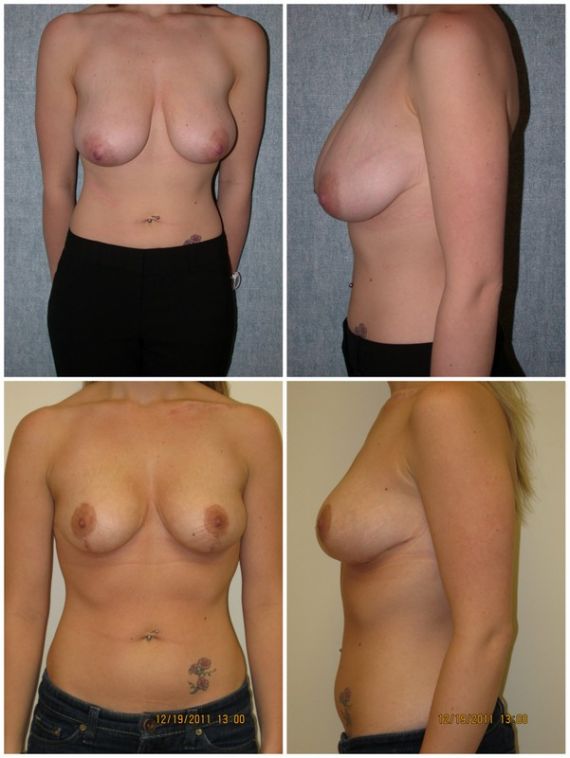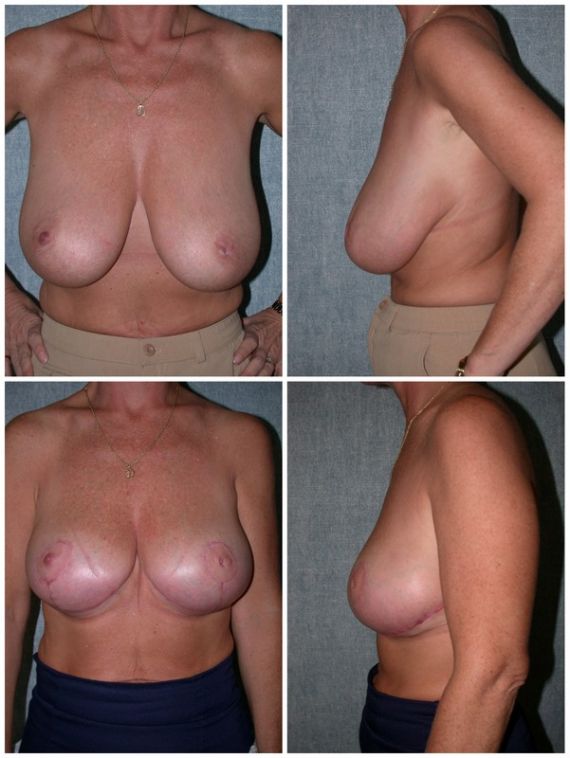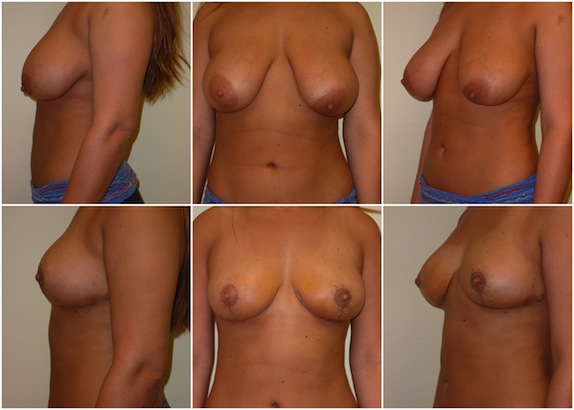Breast Reduction Surgery
Also known as reduction mammaplasty, breast reduction surgery removes a combination of excess fat, glandular tissue and skin to achieve a breast size in proportion with your body and to alleviate the symptoms associated with overly large breasts. It is one of the most commonly performed plastic surgery procedures and provides vast numbers of women relief from the problems associated with large breasts. The discomfort caused by excessively large breast is known as symptomatic macromastia and includes neck and upper back pain, shoulder notching, chronic irritation of the fold under the breasts, and poor posture. Many women have suffered for decades with these symptoms and their lives are changed dramatically after removing the pendulous, excessive weight that they have been carrying around for so long.
There are different surgical techniques that are selected depending on how large a woman’s breasts are and her desires in terms of the amount of reduction. Some women wish to be as “small as possible” while most would like to reduce their breast size so as to be in proportion and also reduce the symptoms of macromastia. In almost all cases, the nipple and areola are left attached to the breast and sensation to the nipple preserved. Only in cases involving massive breasts are alternate techniques considered. The goal is to provide you with a pleasing shape and size that also eliminates the symptoms mentioned above.
The Consult
At the time of your consultation, your breasts will be examined for nipple position and skin quality as well as to make a determination of the amount to be removed. All of the details of the procedure will be discussed including the location of your scar, the routine on the day of surgery, what to avoid immediately before and after surgery, and things you can do to optimize your result.
Many photos are available for you to view as are past patients to whom you can speak for support if you desire. If you decide to have surgery, you will receive paperwork detailing pre- and post-operative instructions, consents, prescriptions and everything else you might need to make the procedure as stress-free as possible. Together we will plan your procedure so as to restore the form and function you are seeking.
FAQs
A breast reduction usually takes about two hours to complete. You then spend several hours in the recovery room until you are drinking fluids, walking around, and are able to go to the bathroom. A bra will be in place to help maintain gentle pressure and provide comfort during the early portion of your recovery. Unless you have a pre-existing medical issue, you will not be required to stay overnight in the hospital, although it can be arranged if you desire to do so. Virtually none of my breast reduction patients over the last 8 years have needed a hospital stay and our safety record has been outstanding. Patients that live more than an hour away stay in a local hotel and are seen in the office the following morning prior to your departure for home.
Breast reduction is performed under general anesthesia. This is the safest method and allows you to receive medications to minimize your pain and any anxiety you may have surrounding the time of surgery. Multiple agents are administered to prevent nausea and vomiting so you should not be concerned about that being an issue postoperatively. You will wake up gradually and sleep in the recovery room for several hours and before you know it you will be up and able to walk to the bathroom.
You will have a very modest amount of discomfort the first few days, but it improves quickly as you begin to become more active. Since only skin, fat and breast tissue are resected the only pain you feel afterward is a low-level burning sensation along the incisions. A combination of medications will be provided and I encourage you to take whatever you need during those first two or three days to be comfortable. The most important thing to remember is to take what you need prior to the onset of pain. Most patients are able to manage their pain with Tylenol or Advil within a day or two after surgery.
I require you to walk several times the evening of surgery. The most important thing you can do to minimize pain and decrease the risk of complications is early ambulation and keeping yourself well-hydrated. I tell my patients to act as if they had a bad cold, meaning you still remain active but get as much rest as you can. I encourage you to resume light exercise within a few days and even allow you to walk around outside or on a treadmill if you desire. After six weeks I remove all restrictions and you can do as many sit-ups or run a marathon if you wish. You will be required to wear a bra with excellent support for the first 3-4 weeks for most of the time every day. You will be permitted to remove it for several hours a day while relaxing at home but are advised to wear it while sleeping and when out and about.
The incidence of major complications from breast reduction in my practice is exceedingly low and certainly below 1%. The risk of nipple-loss is present but has not happened in my hands to date. Minor complications include small areas of skin breakdown, infection and bleeding but are, as I mentioned above, exceedingly infrequent. As with all of my procedures, we make sure you are cleared by your regular physician and check all pertinent lab work that may be indicated.
The majority of my procedures are performed at the Bedford Ambulatory Surgery Center (BASC) located just off Rte. 293 on South River Rd. in Bedford. The BASC is known for being a very comfortable and convenient setting, and has an outstanding reputation for patient safety. Certain procedures are done at The River’s Edge facility located adjacent with the Queen City Bridge in Manchester, NH. The staff at both locations is highly trained to care for my cosmetic surgery patients and almost all comment on how well they were treated.
We see you in the office the morning after surgery to exam you and answer any questions you may have. Then you are seen at 1, 3, 6 and 12 months, all included in the cost of surgery.
Please visit the gallery for photos (many more photos are available in the office):
